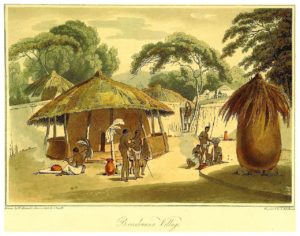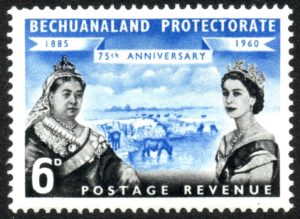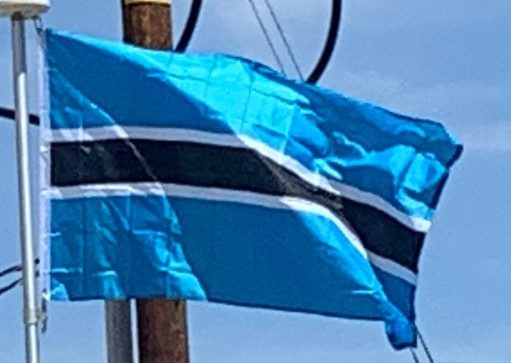Following the Great Trek, Afrikaners from the Cape Colony established themselves on the borders of Botswana in the Transvaal. In 1852 a coalition of Tswana chiefdoms led by Sechele I resisted Afrikaner incursions, and after about eight years of intermittent tensions and hostilities, eventually came to a peace agreement in Potchefstroom in 1860. From that point on, the modern-day border between South Africa and Botswana was agreed on, and the Afrikaners and Batswana traded and worked together ‘peacefully’.
Due to newly peaceful conditions, trade thrived between 1860 and 1880. Taking advantage of this were Christian missionaries. The Lutherans and the London Missionary Society both became established in the country by 1856. By 1880 every major village had a resident missionary, and their influence slowly became felt. Khama III (reigned 1875–1923) was the first of the Tswana chiefs to make Christianity a state religion, and changed a great deal of Tswana customary law as a result. Christianity became the de facto official religion in all the chiefdoms by World War I.
Colonialism and the Bechuanaland Protectorate:
During the Scramble for Africa the territory of Botswana was coveted by both Germany and Great Britain. During the Berlin Conference, Britain decided to annex Botswana in order to safeguard the Road to the North and thus connect the Cape Colony to its territories further north. It unilaterally annexed Tswana territories in January 1885 and then sent the Warren Expedition north to consolidate control over the area and convince the chiefs to accept British overrule. Despite their misgivings, they eventually acquiesced to this fait accompli.

In 1890 areas north of 22 degrees were added to the new Bechuanaland Protectorate. During the 1890s the new territory was divided into eight different reserves, with fairly small amounts of land being left as freehold for white settlers. During the early 1890s, the British government decided to hand over the Bechuanaland Protectorate to the British South Africa Company. This plan, which was well on its way to fruition despite the entreaties of Tswana leaders who toured England in protest, was eventually foiled by the failure of the Jameson Raid in January 1896.
When the Union of South Africa was formed in 1910 from the main British colonies in the region, the High Commission Territories — the Bechuanaland Protectorate, Basutoland (now Lesotho), and Swaziland (now Eswatini) — were not included, but provision was made for their later incorporation. However, the UK began to consult with their inhabitants as to their wishes. Although successive South African governments sought to have the territories transferred to their jurisdiction, the UK kept delaying; consequently, it never occurred. The election of the Nationalist government in 1948, which instituted apartheid, and South Africa’s withdrawal from the Commonwealth in 1961, ended any prospect of the UK or these territories agreeing to incorporation into South Africa.

An expansion of British central authority and the evolution of tribal government resulted in the 1920 establishment of two advisory councils to represent both Africans and Europeans. The African Council consisted of the eight heads of the Tswana tribes and some elected members. Proclamations in 1934 regulated tribal rule and powers. A European-African advisory council was formed in 1951, and the 1961 constitution established a consultative legislative council.
Independence:
In June 1964, the United Kingdom accepted proposals for a democratic self-government in Botswana. The seat of government was moved in 1965 from Mafikeng in South Africa, to the newly established Gaborone, which is located near Botswana’s border with South Africa. Based on the 1965 constitution, the country held its first general elections under universal suffrage and gained independence on 30 September 1966. Seretse Khama, a leader in the independence movement and the legitimate claimant to the Ngwato chiefship, was elected as the first President, and subsequently re-elected twice.
